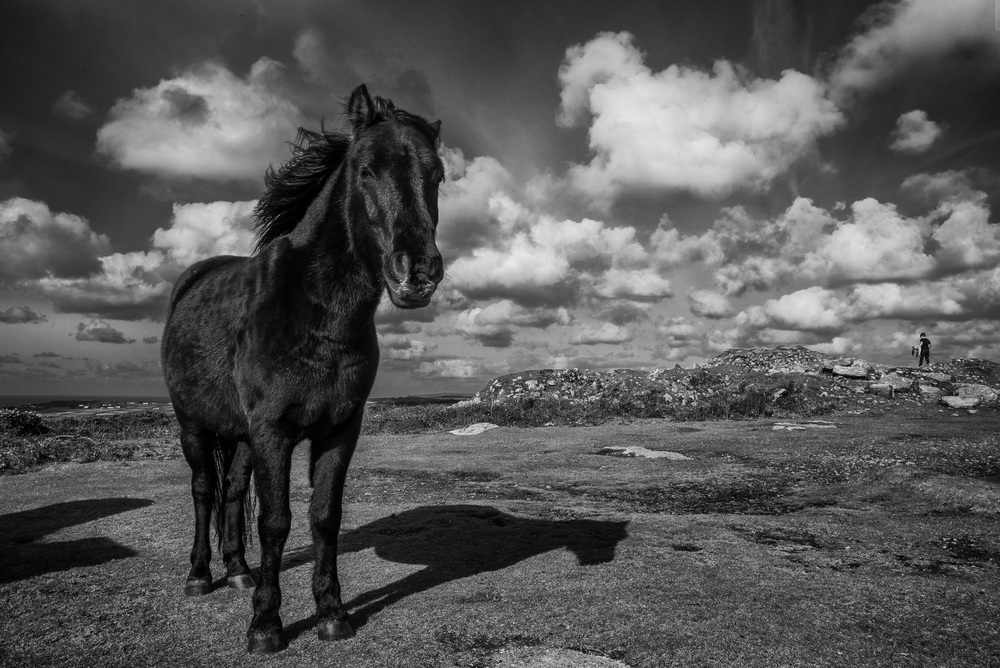
Leica quietly introduced new versions of three of their most popular lenses earlier this year:
- 35mm f/2 Summicron ASPH: with extra aperture blades
- 28mm f/2.8 Elmarit ASPH: with an improved optical formula
- 28mm f/2 Summicron ASPH: with an improved optical formula
All three lenses have Leica’s improved, screw-in lens hoods.
I tested all three of the new lenses in Autumn 2015, culminating in a big comparative test in Venice between the new and old lenses on three different cameras (a Leica M240, a Sony A7 Mark II and the Leica SL).
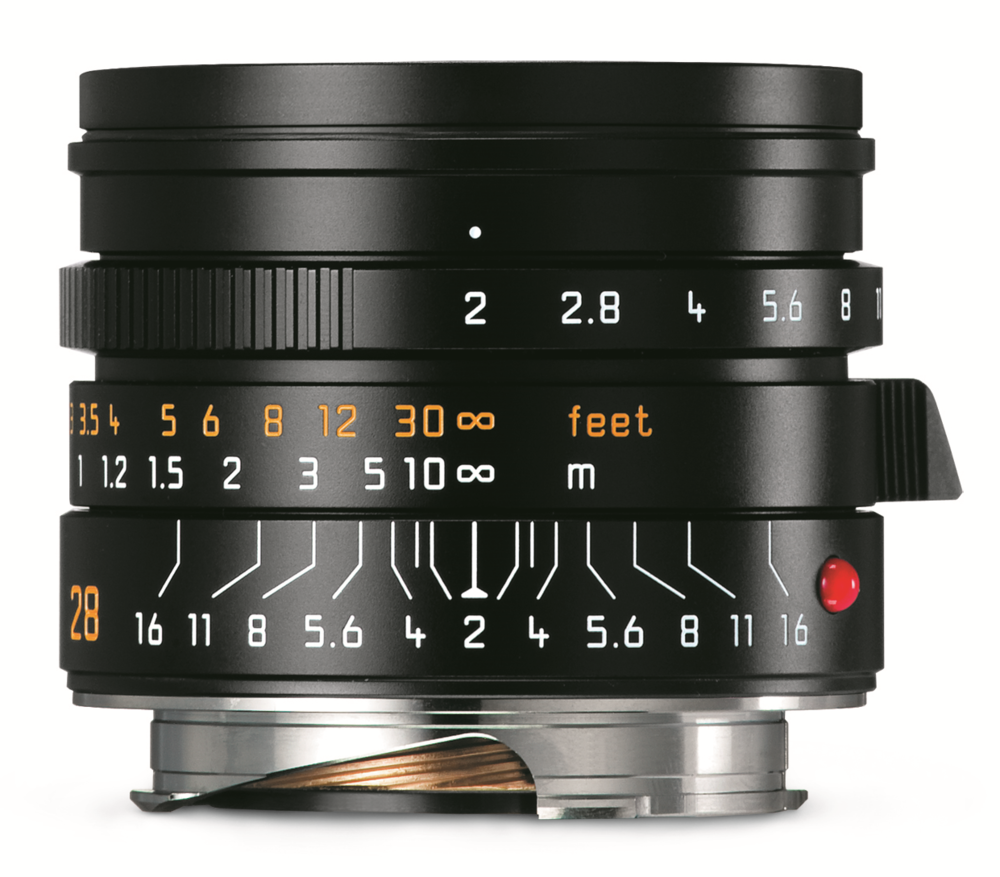
The results were pretty clear; the new 28mm lenses showing obvious advantages over the older lenses. However, these were prototype products, so it wasn’t reasonable to publish images from them.
In the meantime Sean Reid has written an excellent article about the lenses on the M240 and the SL at Read Reviews (small subscription required, but well worth it) with a field report as well as his thorough studio tests.
I used the previous 28 Summicron for several years, selling it only on the introduction of the peerless 28 Summilux ASPH. The Summilux, however, is a comparatively large and heavy lens and I was so impressed with the prototype models that I have recently bought one of the new 28 Summicrons, especially for travelling light.
Judging by the Internet discussions and my email correspondence, it seems to me that the improvements with these lenses are not very well understood. So it occurred to me that it might be worth doing a comparative test. A trip to Le Marche in Italy to meet up with Vieri Bottazini seemed like an excellent opportunity to take some infinity shots in the clear Appenine air.
Ivor Cooper at Red Dot Cameras in London was kind enough to lend me one of the older 28 Summicron lenses and my son Silas handed over his Sony A7 Mark II for the weekend.
It would have been nice to have had the f/2.8 Elmarits for the test, but in the end it proved too complicated to get hold of the lenses in the short timescale. My previous tests in Venice had shown me that the improvements were pretty equivalent, so it still seemed worthwhile testing the 28 Summicron alone.
The 28 Summicron Aspherical
This lens has been a favourite for Leica shooters since its introduction in 2000; whilst being perfectly sharp it has a gentler rendition than most high-quality wide-angle lenses. It is loved by reportage, street and landscape shooters alike.
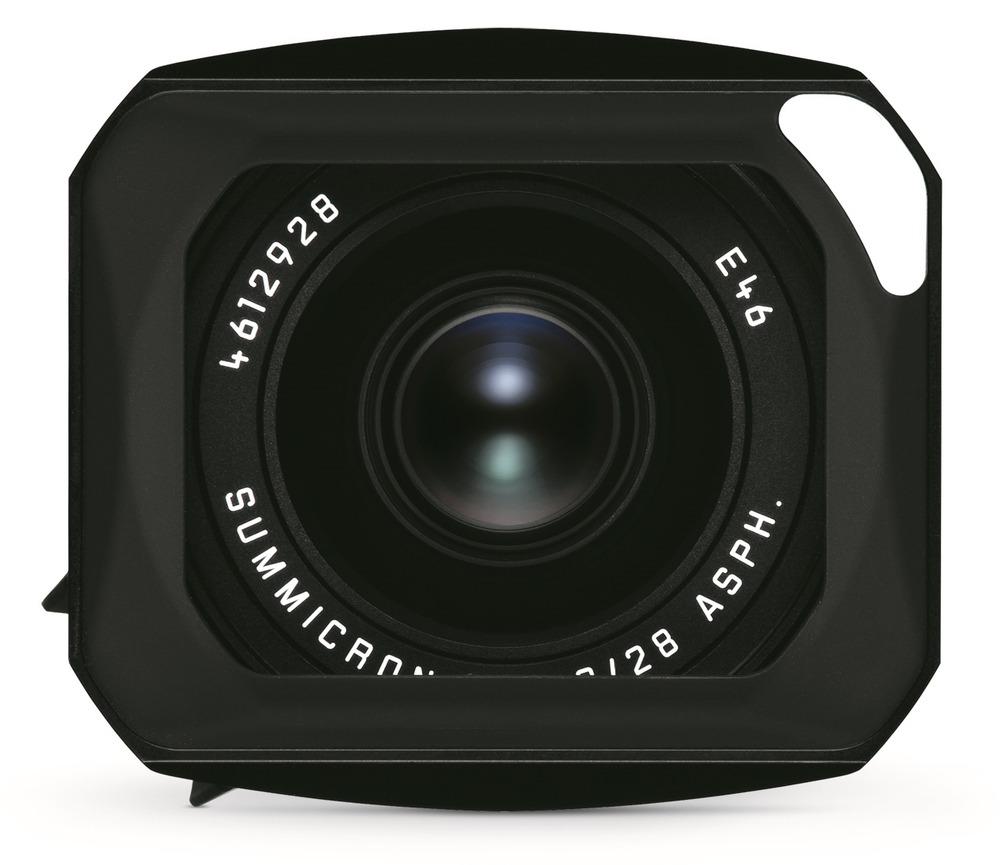
However, it is one of the most demanding lenses when used on third-party cameras, especially full-frame cameras such as the Sony A7 range and of course the Leica SL. The rear exit pupil is very close to the ‘film’ plane, creating a sharp angle of incidence to the sensor; this is not nearly so critical with the film cameras for which the original lens was designed, but the cover glass thickness and photosite microlens design on digital cameras can cause real problems in terms of soft corners and colour shift across the frame.
The special microlens design on the M240 sensor together with firmware profiles and the relatively thin coverglass has helped to make the lens a fine performer. The Leica SL also includes firmware correction for the lens. Nevertheless, it’s one of the few M lenses which performs better on the M240. On the Sony A7 cameras (in my opinion) it’s been one of the no-go lenses.
Design Changes
All three of the new lenses incorporate the use of the modern style screw-in metal lens hood. This is a great improvement; the old lens hoods were large and unwieldy with a metal connection which could easily scratch the lens barrel and, worse than this, they tended to drop off easily.
Apart from this, looking from the outside, the difference between the older 28 lenses and their replacements is not very obvious. However, the optical formula has been radically improved, especially for use with digital cameras. The lenses have had the curvature of field reduced (making corners and edges sharper at wide aperture) and the 28 Summicron has had its MTF figures improved.
The 35mm Summicron has not had its optical formula changed. However, it does have two more aperture blades which create a rounder aperture opening and should improve the bokeh (except when wide open of course).
Testing Considerations
The rear element of M lenses is closest to the sensor at infinity, so it’s best to test these lenses as close to infinity as possible, which is not always such an easy task, in particular as air conditions (and especially heat haze) can seriously affect the results.

I have also included some shots of an old shed, these were taken in the UK from about 4 metres. It was interesting doing these tests, as it made it very clear to me how great the curvature of field is on the older lens (not something I had realised in normal shooting…. I just knew that if you focused using the rangefinder you got soft corners!).
Whilst the infinity stop on Leica rangefinder cameras usually closely matches infinity on the lenses, this isn’t usually the case on mirrorless cameras which will often focus beyond infinity, so it’s important to do focus bracketing to ensure the best possible focus in each case.
Exposure is also fairly tricky, principally at wide aperture where vignetting is an issue, and especially with the Sony camera, which doesn’t have profiles for M lenses. There might be an argument for doing a comparison with the lens profiles turned off on the Leica cameras, but although the results would be interesting, they wouldn’t represent real world usage.
I have included the Sony because many Sony users shoot with M lenses, some even going so far as to modify the Sony sensor to reduce the thickness of the coverglass. This report is not intended as any kind of criticism of Sony, who produce excellent and exciting cameras, and who couldn’t be expected to optimise them for the use of Leica lenses—especially in the light of their relationship with Zeiss. It is intended to be of use to those Leica lens owners who are considering (or already) using M lenses with a Sony A7.
The three cameras I’ve used are currently the only cameras which shoot full frame digital images with M lenses and whilst there are various models of both the A7 and Leica M cameras, the critical coverglass thickness and microlens design is not changed between models in their respective ranges.
As I’ve mentioned above, the 28mm Summicron is probably the most challenging of the current Leica M lenses for digital cameras. Many of the more modern wide angle designs such as the Summilux wides (21, 24 and 28) are less critical, and the Wide Angle Tri-Elmar produces better results.
Click on the images below to see full-size
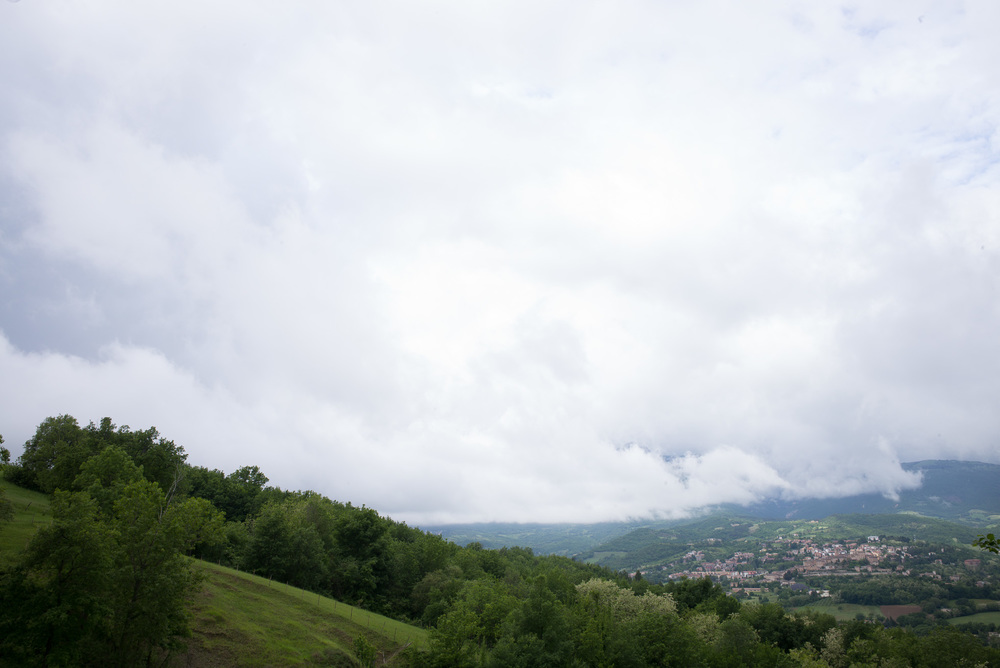
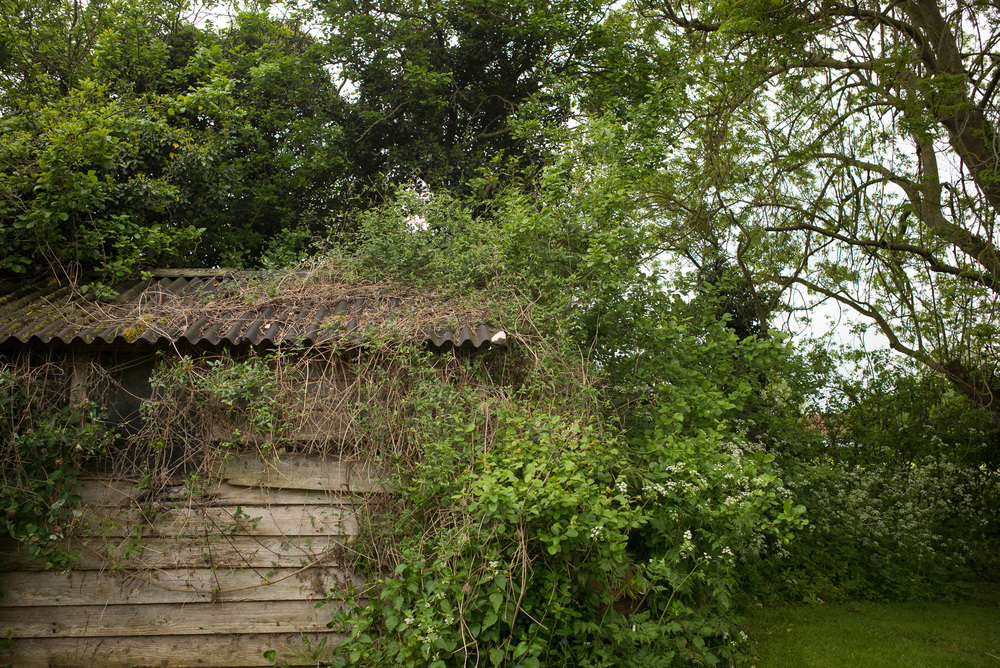
Results
Sadly the lighting in Le Marche was not what one might have wished, but it was fairly consistent. The four-metre shots were taken on a drab grey UK day, not so good for beauty, but quite useful for consistency.
I used daylight white balance for all the shots in Italy, and for the Sony and Leica SL shots of the shed, unfortunately I used auto white balance for the M240 shots of the shed (which is why they are warmer).
I have adjusted exposure, especially necessary as the Sony had much more vignetting (it doesn’t have lens profiles). The idea of the test was to compare resolution and quality, not the vignetting, so I’ve done my best to equalise the lighting.
I’ve taken the same proportion of each corner for the images, of course it also shows the edge definition—not quite to the middle of the frame, but getting close to it. The group jpg shots are made in Photoshop and saved at full resolution. You can click on each image to see the full sized image (and download it if you wish).
Click on the images below to see full-size
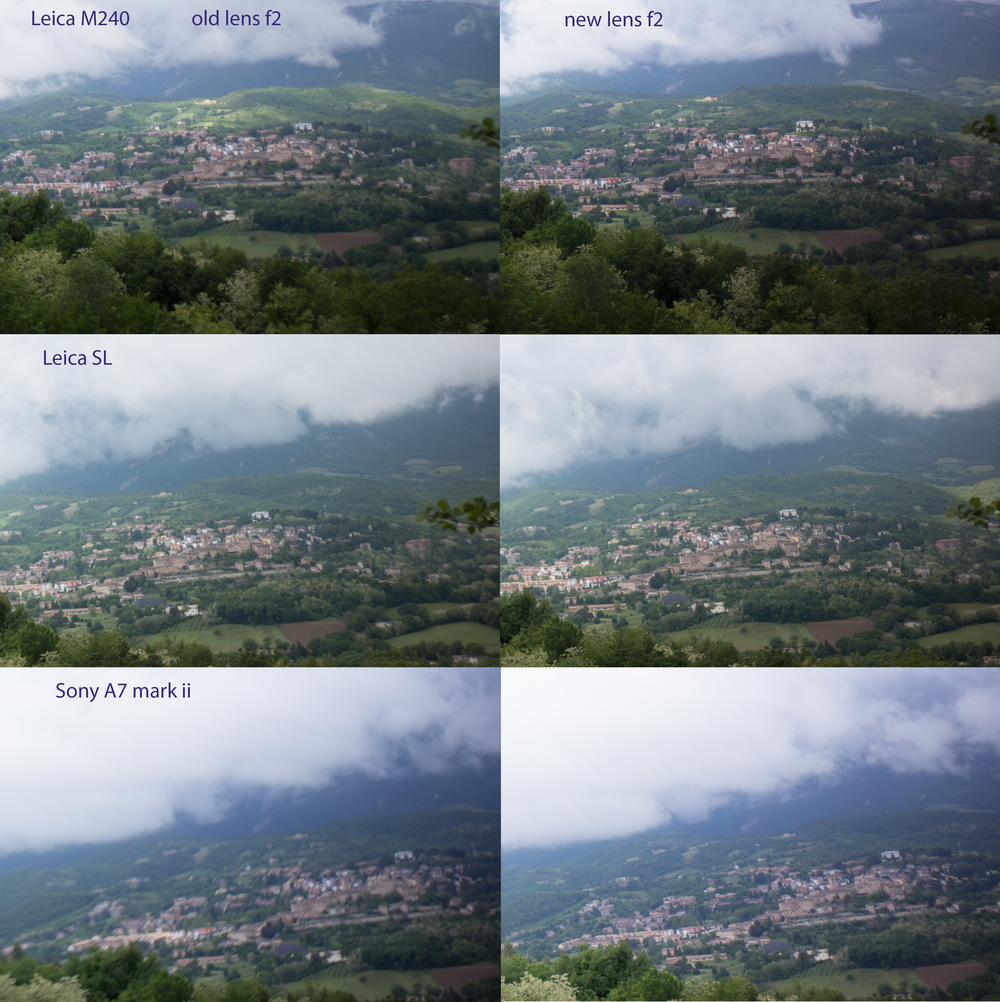
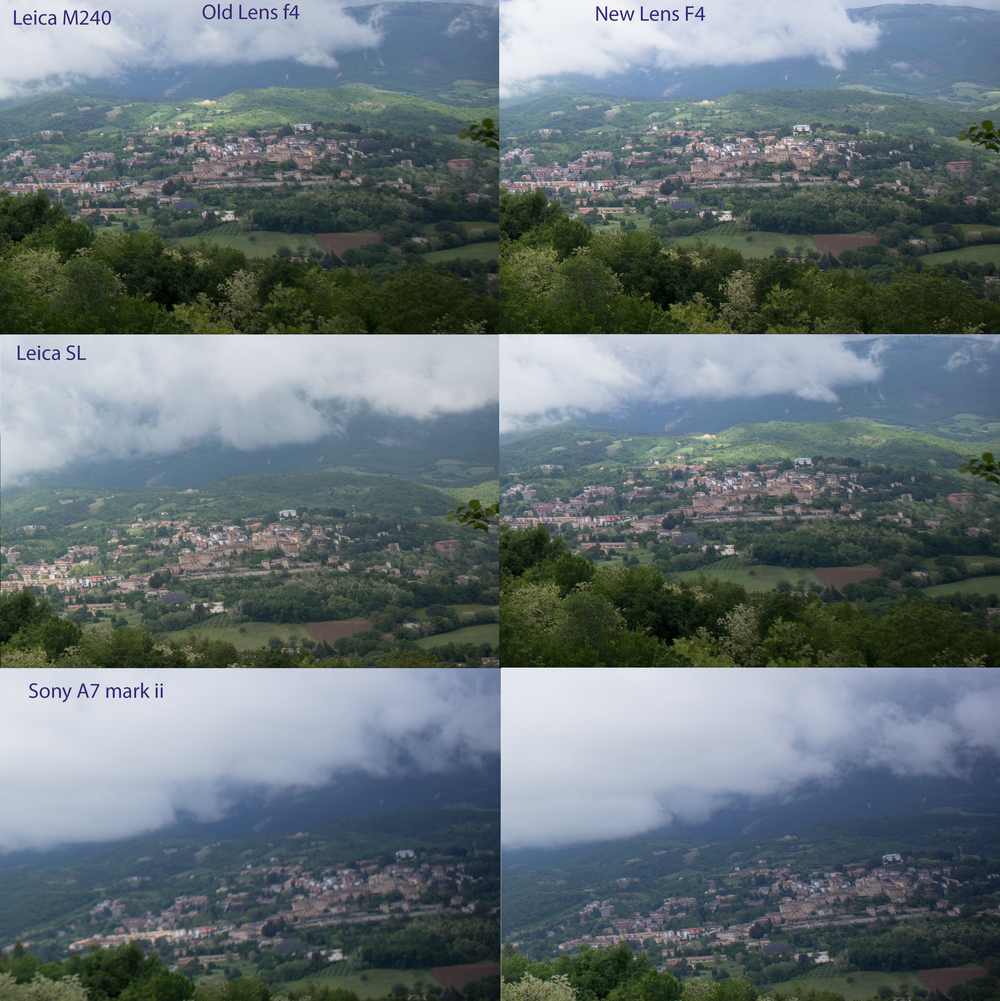
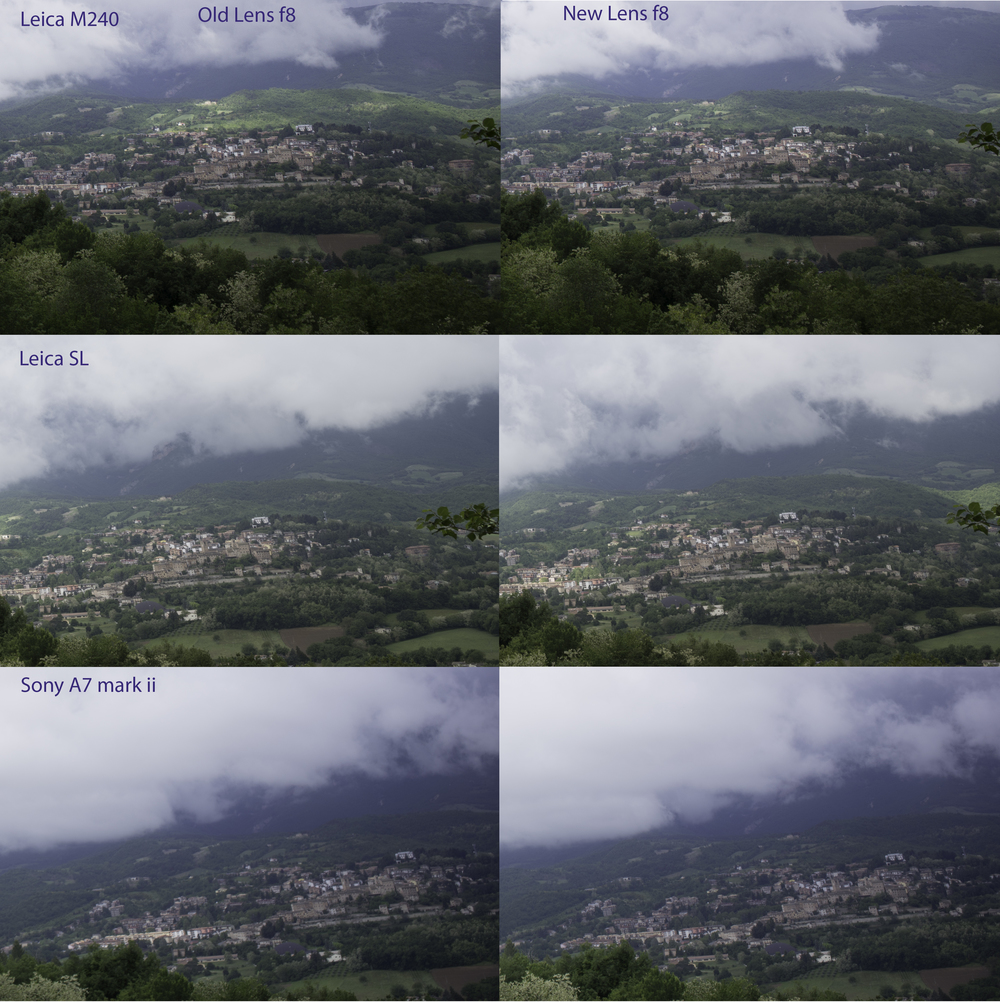
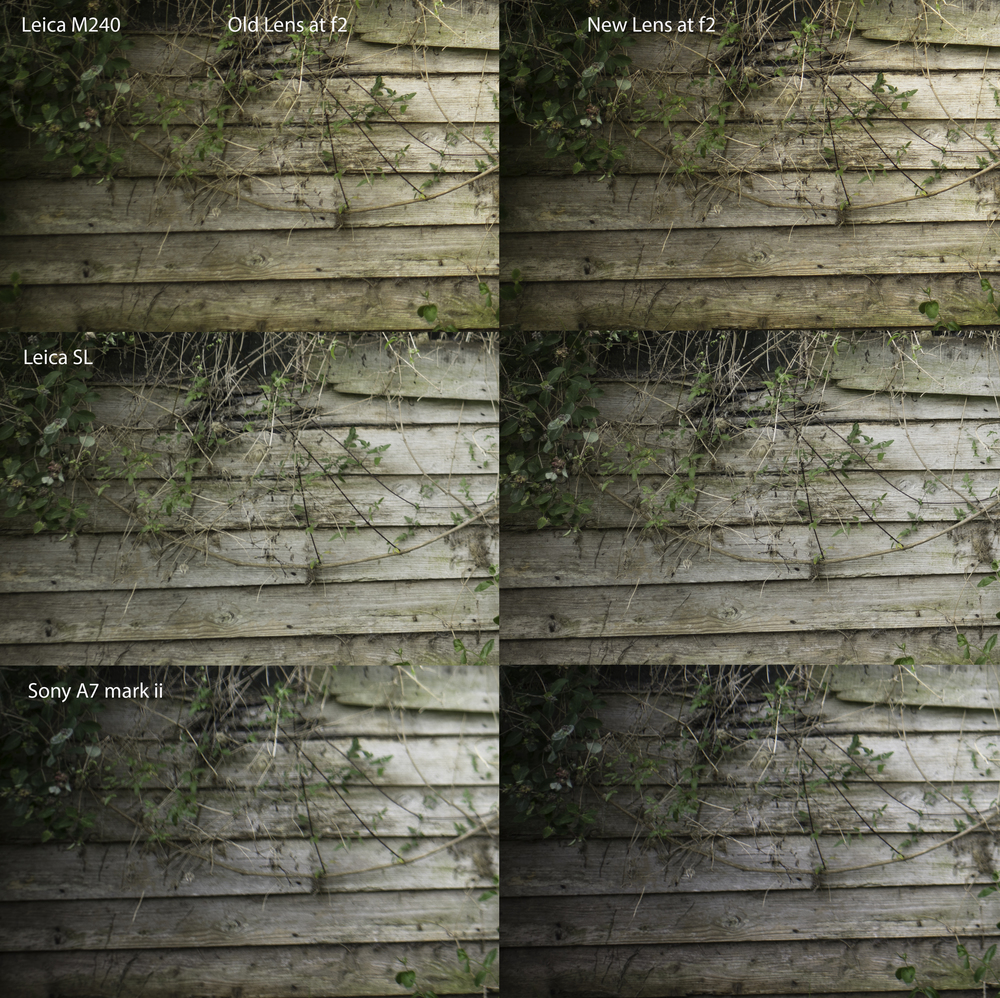
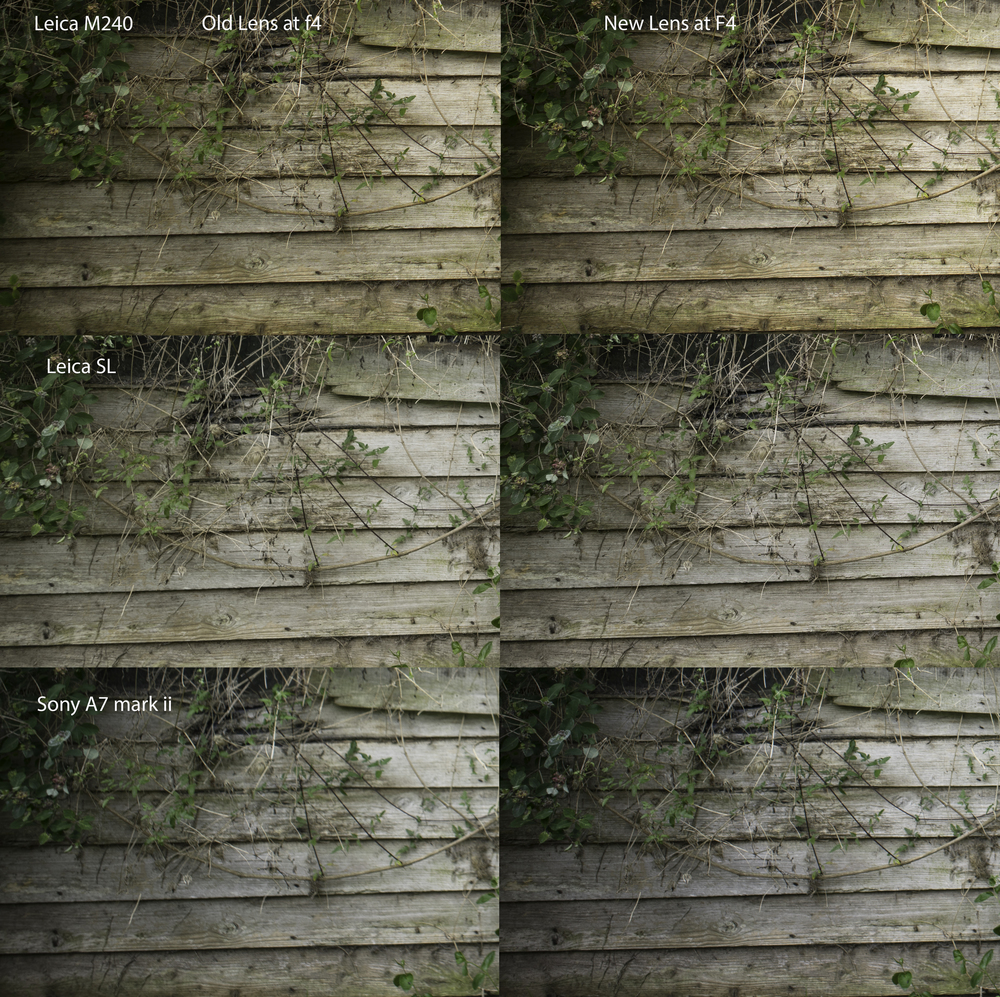
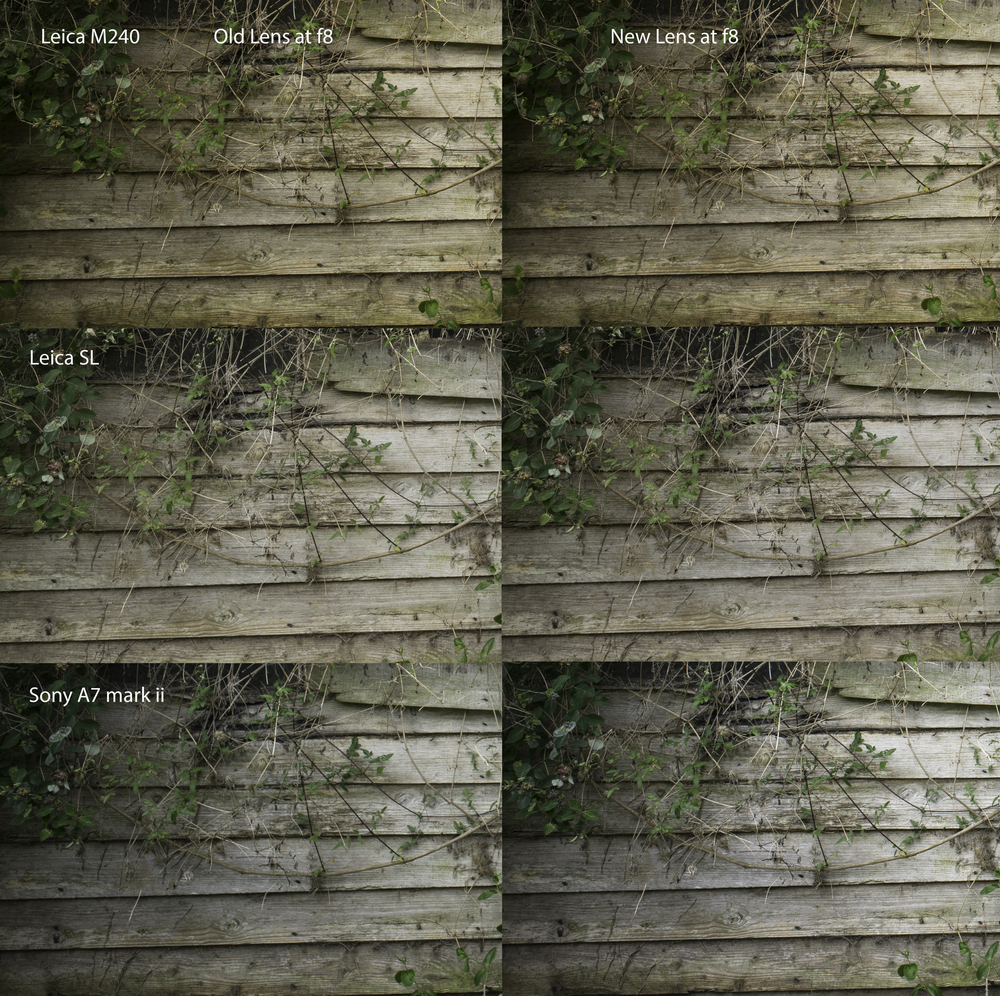
Conclusion
Pretty straightforward really. The new 28 Summicron shows considerable improvement over the old model, especially wide open, and especially with the Leica SL and the the Sony A7 Mk II. The M240 also shows a noticeable improvement, but its micro-lens design and the thin sensor accommodate the older lens better, so the improvement isn’t nearly so obvious.
I think it also shows that if you want to use this (and other) M lenses for landscape work, then the SL does a much better job than the Sony, but if you want the very best performance, then the Leica M is still the best camera to use with M lenses.
You can download full-sized images of the test shots here
If you have found this article useful, you might like to make a donation to Cancer Research. My wife Emma is once again doing the Ladies Tractor Road Run on 3 July 2016. If you would like to contribute click on this link.
________________________________________
- All images in this article ©Jonathan Slack. Product shots courtesy of Leica.
- You can read more from Jonathan Slack at Slack.co.uk
- Subscribe to Macfilos for free updates on articles as they are published. Read more here
- Want to make a comment on this article but having problems? Please read this

Great write-up, and convinced me to get a 28 Cron, only the old one. One huge benefit of this ne lens is that prices on the older model have really dropped, to the point where the 28 Cron is only a few hundred dollars more than the 28 Elmarit was this time last year. Since I shoot on an M-E and (original) M Monochrom (as well as film), most of the benefits of the new lens would be lost on me, while the extra money in my pocket most definitely is not.
Hi Everyone
if you would like to download the originals of the 6 shots then you can get them here:
https://dl.dropboxusercontent.com/u/3808779/Summicron_article_images.zip
All the best
Jono
Are you sure you have the right lens picture? That lens looks just like the old Summicron and I don’t see the thread for the hood.
Hi James, I checked earlier with Leica because I had some worries about this. They do look very similar. The answer is that this is indeed the new 28mm Summicron but it is wearing the keeper ring. You need to remove this in order to screw in the hood. It’s a strange arrangement and, of course, that ring is easy to lose. I’d recommend leaving it in the box if you buy one of these lenses; it will probably spend most of its time with the hood attached anyway.
Thanks for the interesting article, Jono. I have the previous 28mm Summicron and I was not really aware of the differences introduced in the new model. The sample photos are small, but I do see some improvement on the M. Probably not enough to justify upgrading for me, however, as I am already very happy with the lens.
I am not really interested in the SL or the Sony camera images, but you are right in saying that the best camera for Leica M lenses is an M design rangefinder. You are also right in saying that the angle at which the light hits the sensor can affect the quality of the image at the edges. With cropped sensors there is a counterbalancing beneficial effect which can improve this situation as you are not using the whole of the lens to create the image. You are also right in saying that the corner issue can vary according to different lens designs. I never know how well a particular lens will work in a ‘non-native’ situation until I have actually used it in the field to shoot some photos. The handling and ergonomic issues are also important and I still feel that focus peaking has a bit to go before catching up with the Leica rangefinder system.
I often use old lenses on modern cameras and the same issues arise. Sometimes I use the so-called ‘defects’ in early lenses to create a different type of image. In addition the cropped sensors can be beneficial there too. A particular marriage made in heaven was the Summar on the M8 which can produce very sharp images at the centre when shot at or near to wide open with the added bonus of the most wonderfully weird ‘bokeh’ I have ever seen. A true case of a defect being an ‘added bonus’.
I have quite a few Summicrons, 28, 35, 50 and 90 plus two from the 1950s, collapsible and the 50 DR. I only use the last two on cameras from their era; the 50DR will not work on digital Ms anyway. I rarely use the 90 on digital cameras as it has focus issues but it is perfect for film. The 28, 35 and 50 are 3 of my ‘go to’ lenses as I find them most reliable for all types of photography. I have an older 35 Summilux Asph but my 35 Summicron is just as good. I also have the 50 Summilux Asph but I only use it for special occasions as it is the heavy chrome version. I am interested in your comments on the 28 Summilux. While I am pleased with the 50 Summilux, I would need some persuading to move from the 28 Summicron to the Summilux version. Can you say what the main advantages are with the Summilux version apart from the wider maximum aperture?
William
Hi There William
First of all, I recommend that you download the full sized files:
https://dl.dropboxusercontent.com/u/3808779/Summicron_article_images.zip
clicking on the images here does bring up a larger version – but still not 100%
Having been a real advocate for focus peaking, I now cordially dislike it – it seems to me that it’s often misleading, picking up oof high contrast areas – and the first thing I do on all EVF cameras is to switch it off. In most instances I don’t zoom in either – you can pretty easily tell what’s in focus on decent EVFs without the necessity of zooming – indeed, I think the huge EVF on the SL is often easier to focus M lenses than the rangefinder. But the point about a rangefinder is that it’s a rangefinder – I still like them best!
I thought it only took a small modification to make the 50 DR to work on modern rangefinders? I certainly used one for a while. I’ve got the chrome version of the 50 Summilux as well, I use it for events, usually when I’m not carrying any other lenses – I love the look on my chrome M-P . . . but it is heavy!
The 28 summilux really is a cracking lens – it’s rather large for travelling, but generally speaking I think it’s the best of the 28s – and the wide aperture can be fun for creating out of focus backgrounds (I especially like it for nature photography).
All the best
Jono
Hi There Stephen
I guess there are a few shed’s like that . . Actually it’s Emma’s shed, and it has a wonderful Clematis which I’ve photographed many times.
I hope that Mike gave you a good deal – I suspect that he might regret it! (my M-P is firmly clutched to my chest).
I meant sheds (oh dear!)
Just a minute that looks like my old shed…!
Have you been sneaking about in my former back garden Mr. Slack?
But seriously, I am glad that I have bought Mike’s old M-P (240) and I am looking forward to acquiring a wider lens to to go with my 40mm Minolta, which though very old, is a very good Leitz design. We shall have to see whether this even lighter 28 Summaron becomes a reality.
Thanks for the review.